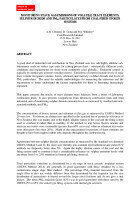Air monitoring
MONITORING STACK GAS EMISSIONS OF VOLATILE TRACE ELEMENTS, SULPHUR DIOXIDE AND PM10 PARTICULATES FROM COAL-FIRED STOKER SYSTEMS
Oct 06 2014
Author: A.H. Clemens, D. Gong and R.S. Whitney on behalf of CEM
ABSTRACT
A good deal of industrial coal combustion in New Zealand uses low ash highly alkaline subbituminous coals on stoker type units for raising process heat - substantially different coals, conditions and requirements for those most commonly used globally. Emissions control is typically by inertial grit arrestors (multicyclones). Emissions of interest include levels of toxic trace volatile inorganics (arsenic, boron, selenium, and mercury) sulphur dioxide and levels of PM10 particulates. The need for reliable methodologies for measuring the emissions and the requirement to better understand the factors responsible for them is becoming increasingly important.
This paper presents the results of trace element mass balances from a series of laboratory combustion trials. It also presents comparisons from laboratory combustion trials and from industrial sites of monitoring sulphur dioxide emission levels as measured by standard and nonstandard methods, and PM10.
The concentrations of boron, arsenic and selenium in flue gas as measured by USEPA Method 29 were low. For boron, an element not specified in the standard but of particular relevance to New Zealand, this was mainly due to the highly alkaline nature of the coal and the firing system used to combust it rather than to inability of the method to trap boron. Boron, arsenic and mercury recoveries were reasonable (greater than 60% recovery) whereas selenium recoveries were often poor (less than 20%). Much of the unaccounted for portions of these elements are thought to have been trapped within ashy deposits throughout the combustion rig.
Agreements between sulphur dioxide concentrations as measured by the standard wet chemical USEPA Method 6 and by the more user friendly non-standard electrochemical and pulsed UV methods are frequently better than 5%. Again the highly alkaline nature of the coal and the firing system used to combust it had a considerable influence on sulphur emission levels with anywhere from 5 to 25% retention in bottom ash being observed.
Total particulate emissions as determined by a six-stage in stack cascade impactor system (USEPA Method 201A) are generally in good agreement with those obtained by a less cumbersome single stage filter method. The percentage PM10 material recovered from the single filter is also not widely different from that determined by the impactor but the size distribution of particulates is biased toward the larger sized fractions and do not give a true picture. The mean PM10 emission factor (63%) was in good agreement with those cited by the USEPA (55 to 65%) for stoker type firing systems with inertial grit arrestors.
INTRODUCTION
Increased public concern relating to the release of potentially harmful emissions from combustion processes at industrial sites is leading to legislation aimed at reducing emissions. The need for reliable methodologies for measuring the emissions and the requirement to better understand the factors responsible for them is becoming increasingly important. Among the targeted emissions are chemical species such as sulphur dioxide and the toxic volatile inorganics arsenic, boron, selenium and mercury 1-3. Also targeted are particulate emissions - especially those designated as being of less than 10 microns in diameter (PM10 particulates) and believed to be sufficiently small to enter the respiratory system and bring about related health problems 4,5.
Coal-fired combustion is accompanied by emissions in each of these areas and it is important, given its significance as a fuel, that its contribution is determined accurately and understood as fully as possible.
In New Zealand, many industrial coals are low ash (3 to 8%) sub-bituminous rank with high levels of calcium (up to 60% CaO in ash may be found). The coals are typically used in stoker, and occasionally fluidised bed, combustion conditions. Given the difference in combustion regimes and the highly alkaline nature of the coal ashes it is possible that sulphur, particulate and trace element emissions and partitioning behaviour may not follow the trends seen in the majority of previous studies. Of particular interest is the trace element boron which is present in moderate to high concentrations in New Zealand coals. In the course of conducting research to quantify and understand the emission levels of these species from New Zealand industrial coals under New Zealand conditions it has been necessary to monitor their emissions on a number of occasions from a number of sites using a variety of monitoring methods.
A great deal of the available data relating to particulate, sulphur and trace element emissions comes from power stations using pulverised bituminous coal- i.e. a high temperature (1250 to 1500°C) combustion regime characterised by fine particles and short residence times. There is less data relating to fluidised bed combustion where the temperatures are lower (800 to 950°C) but residence times are much longer. There is also comparatively little data for stoker systems where intermediate temperatures, long residence times, large particles and comparatively static beds are encountered. In addition most of the data is for cases where the ash generated during combustion is dominated by oxides of silicon, aluminium and iron with comparatively small contributions from the alkaline earth oxides typical of New Zealand coal ashes.
This paper presents and discusses the results of trace element mass balances from a series of laboratory combustion trials, comparisons of sulphur dioxide emission levels as measured by standard and non-standard methods and PM10 monitoring from industrial sites.
Digital Edition
AET 28.4 Oct/Nov 2024
November 2024
Gas Detection - Go from lagging to leading: why investment in gas detection makes sense Air Monitoring - Swirl and vortex meters will aid green hydrogen production - Beyond the Stack: Emi...
View all digital editions
Events
Jan 20 2025 San Diego, CA, USA
Carrefour des Gestions Locales de L'eau
Jan 22 2025 Rennes, France
Safety, Health & Wellbeing LIVE
Jan 22 2025 Manchester, UK
Jan 25 2025 San Diego, CA, USA
Jan 29 2025 Tokyo, Japan















